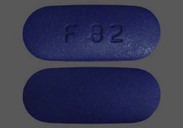V
Drug Class:
Indications and Dosages
 Prevention of Genital Herpes
Prevention of Genital Herpes
PO
 Dosage in Renal Impairment
Dosage in Renal Impairment
Dosage and frequency are modified on the basis of creatinine clearance.
| Creatinine Clearance | Herpes Zoster | Genital Herpes |
| 50 ml/min or higher | 1 g q8h | 500 mg q12h |
| 30–49 ml/min | 1 g q12h | 500 mg q12h |
| 10–29 ml/min | 1 g q24h | 500 mg q24h |
| Less than 10 ml/min | 500 mg q24h | 500 mg q24h |
Precautions and Contraindications
Hypersensitivity to or intolerance of acyclovir, valacyclovir, or their components
Dental Considerations
General:
• Determine why the patient is taking the drug.
• Be aware of general discomfort associated with shingles; acute symptoms may preclude patient’s routine dental visit or mandate short appointments.
• Patients on chronic drug therapy may rarely have symptoms of blood dyscrasias, which can include infection, bleeding, and poor healing.
Drug Class:
Indications and Dosages
 Prevention of CMV after Transplant
Prevention of CMV after Transplant
PO
 Dosage in Renal Impairment
Dosage in Renal Impairment
Dosage and frequency are modified on the basis of creatinine clearance.
| Creatinine Clearance | Induction Dosage | Maintenance Dosage |
| 60 ml/min or more | 900 mg twice a day | 900 mg once a day |
| 40–59 ml/min | 450 mg twice a day | 450 mg once a day |
| 25–36 ml/min | 450 mg once a day | 450 mg every 2 days |
| 10–24 ml/min | 450 mg every 2 days | 450 mg twice a wk |
Dental Considerations
General:
• Patients on chronic drug therapy may rarely have symptoms of blood dyscrasias, which can include infection, bleeding, and poor healing.
• Examine for oral manifestation of opportunistic infection.
• Place on frequent recall to evaluate healing response.
• Consider local hemostasis measures to control excessive bleeding.
Drug Class:
Side Effects/Adverse Reactions
Drug Interactions of Concern to Dentistry
• Increased effects: CNS depressants; carbamazepine, phenobarbital levels may be increased; phenothiazines can lower the seizure threshold
• Increased bleeding and toxicity: salicylates, NSAIDs
• Increased blood levels: erythromycin
• Increased serum levels of amitriptyline, nortriptyline (start with low dose and monitor)
Dental Considerations
General:
• Patients on chronic drug therapy may rarely have symptoms of blood dyscrasias, which can include infection, bleeding, and poor healing.
• Evaluate for clotting ability during gingival instrumentation because inhibition of platelet aggregation may occur.
• Consider semisupine chair position for patient comfort if GI side effects occur.
• Place on frequent recall if gingival overgrowth occurs.
• Ask about type of epilepsy, seizure frequency, and quality of seizure control.
Teach Patient/Family to:
• Encourage effective oral hygiene to prevent soft tissue inflammation and minimize gingival overgrowth.
• Use caution to prevent injury when using oral hygiene aids.
• Use powered tooth brush if patient has difficulty holding conventional devices.
• Schedule frequent oral prophylaxis if gingival overgrowth occurs.
Drug Class:
Side Effects/Adverse Reactions
Precautions and Contraindications
Perforated bladder, sensitivity to valrubicin, severe irritated bladder, small bladder capacity, UTI
Dental Considerations
General:
• If additional analgesia is required for dental pain, consider alternative analgesics (NSAIDs or acetaminophen) in patients taking opioids for acute or chronic pain.
• This drug may be used in the hospital or on an outpatient basis. Confirm the patient’s disease and treatment status.
• Offer patient frequent breaks if urinary frequency is a concern.
• Avoid prescribing drugs that could cause urinary retention, such as drugs with anticholinergic activity.
Drug Class:
Angiotensin II receptor (AT1) antagonist
Mechanism of Action
Therapeutic Effect: Causes vasodilation, decreases peripheral resistance, and decreases B/P.
Dental Considerations
General:
• Monitor vital signs at every appointment because of cardiovascular side effects.
• Limit use of sodium-containing products, such as saline IV fluids, for patients with a dietary salt restriction.
• Stress from dental procedures may compromise cardiovascular function; determine patient risk.
• Short appointments and a stress-reduction protocol may be required for anxious patients.
• Use precaution if sedation or general anesthesia is required; risk of hypotensive episode.
Drug Class:
Glycopeptide-type antiinfective
Indications and Dosages
 Treatment of Bone, Respiratory Tract, Skin, and Soft Tissue Infections; Endocarditis, Peritonitis, and Septicemia; Prevention of Bacterial Endocarditis in Those at Risk (If Penicillin Is Contraindicated) When Undergoing Biliary, Dental, GI, GU, or Respiratory Surgery or Invasive Procedures
Treatment of Bone, Respiratory Tract, Skin, and Soft Tissue Infections; Endocarditis, Peritonitis, and Septicemia; Prevention of Bacterial Endocarditis in Those at Risk (If Penicillin Is Contraindicated) When Undergoing Biliary, Dental, GI, GU, or Respiratory Surgery or Invasive Procedures
Dental Considerations
General:
• Monitor vital signs at every appointment because of cardiovascular side effects.
• Administer IV slowly over 1 hr; administration that is too rapid can lead to a fall in B/P (monitor) and a red rash on the face, neck, and chest caused by local histamine release. No specific treatment is required for this reaction; evaluate recovery progress.
Drug Class:
Indications and Dosages
Precautions and Contraindications
Concurrent use of α-adrenergic blockers, sodium nitroprusside, or nitrates in any form
Drug Interactions of Concern to Dentistry
• Dose adjustments caused by potential drug interactions—do not exceed the maximum single dose of 2.5 mg in a 72-hr period: ritonavir
• Do not exceed 2.5 mg in a 24-hr period: indinavir, ketoconazole (400 mg), itraconazole (400 mg)
• Do not exceed 5 mg in a 24-hr period: ketoconazole (200 mg), itraconazole (200 mg), erythromycin
• Increased plasma levels: drugs that are potent inhibitors of CYP3A4 (e.g., erythromycin, ketoconazole)
Stay updated, free dental videos. Join our Telegram channel

VIDEdental - Online dental courses
























